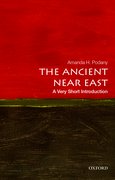|
Reviewed by Dr. Wyndham E. Whynot, Professor of History, Livingstone College The knowledge many people have of the Ancient Near East comes either from a high school history course, their World History 1 class in college, or (for some) the Bible; and much of this information is quite limited in its breadth and depth. Podany’s book, one of several hundred volumes in Oxford University Press’ A Very Short Introduction series, provides a more in-depth examination of this particular region and era. Arguing that the stereotypical view of the period, i.e. “… a story of progress from primitive barbarism to modern sophistication…” (p. 1), fails to accurately depict ancient history, the author seeks to address this failure by showing that some policies and concepts of this era are much more progressive than many people think. Despite the geographical size of the region and the chronological focus on a period of slightly more than 3,000 years, the author provides some limits by restricting her focus solely to what she refers to as the “cuneiform lands,” consisting of Mesopotamia, Elam, Anatolia, and Syria (p. 7). Podany starts with a brief examination of the Ancient Near East from the standpoint of its basic geography, and an examination of the impact of regional archeological excavations on increasing the knowledge of this region and era. She notes that, although numerous primary sources are available, she is focusing only on thirty-three sources for this book. Chapter Two focuses on the early development of cities, and at this point the author begins to move chronologically forward, one empire or civilization per chapter, through the beginnings of the Persian Empire under Cyrus. Each chapter follows a similar pattern: readers are introduced to several of the texts relating to the particular civilization, which are then used to discuss various social, political, religious or other aspects of life and/or the history of that period. As one might expect, Sargon the Great and Hammurabi are discussed, as well as lesser known rulers and individuals who are also brought somewhat to life in the chapters. The role of religion in the region is stressed throughout the various chapters, as the author discuss religious practices as well as the role of religion in government, trade, and wars involving different civilizations. Especially interesting is the discussion of religion’s role in architecture. Podany presents a brief but detailed look at the processes of building ziggurats and palaces. Another major recurring theme involves the region’s different legal systems and law codes. Despite Hammurabi’s place in history for his law codes, the author notes that a variety of civilizations had extensive legal systems and law codes, including the Third Dynasty of Ur whose code existed over three centuries prior to Hammurabi’s. In several chapters, Podany expands on these topics with brief discussions of areas such as diplomacy, international trade, and women’s history. Although mainly focusing on primary texts, the author utilizes a variety of secondary sources. Multiple illustrations of archeological discoveries, such as stela, relief sculptures and tablets, are found throughout the chapters. Two maps are also provided: one covering the entire region, the other focusing on Mesopotamia. Additionally, Podany gives a timeline that provides a chronological scope to the reigns of the rulers she discusses. There are several points of concern, including the author’s decision to limit the scope to only “cuneiform lands,” which means that several civilizations that played a role in shaping the region’s history, such as Israel and Phoenicia, are ignored. Although not a major issue, a minor annoyance for this reviewer was the author’s failure to number the endnotes in the text. Well-written and organized, this work appears suited for undergraduates or individuals seeking a quick refresher on the Ancient Near East, rather than specialists in the region. Furthermore, instructors at the secondary and collegiate level could find this work useful as a supplemental text alongside standard world history texts (many of which come with very limited information about this region and era). Indeed, this could be a valuable companion to some Middle Eastern history texts, such as William Ochsenwald’s Middle East: A History, 8th edition, which covers this period in two pages. This reviewer believes that, despite the somewhat narrow focus of the book (as Podany’s work is indeed very short), it is a welcome addition to the field and has a place in the personal libraries of anyone who teaches world history. |


 The Ancient Near East: A Very Short Introduction
The Ancient Near East: A Very Short Introduction